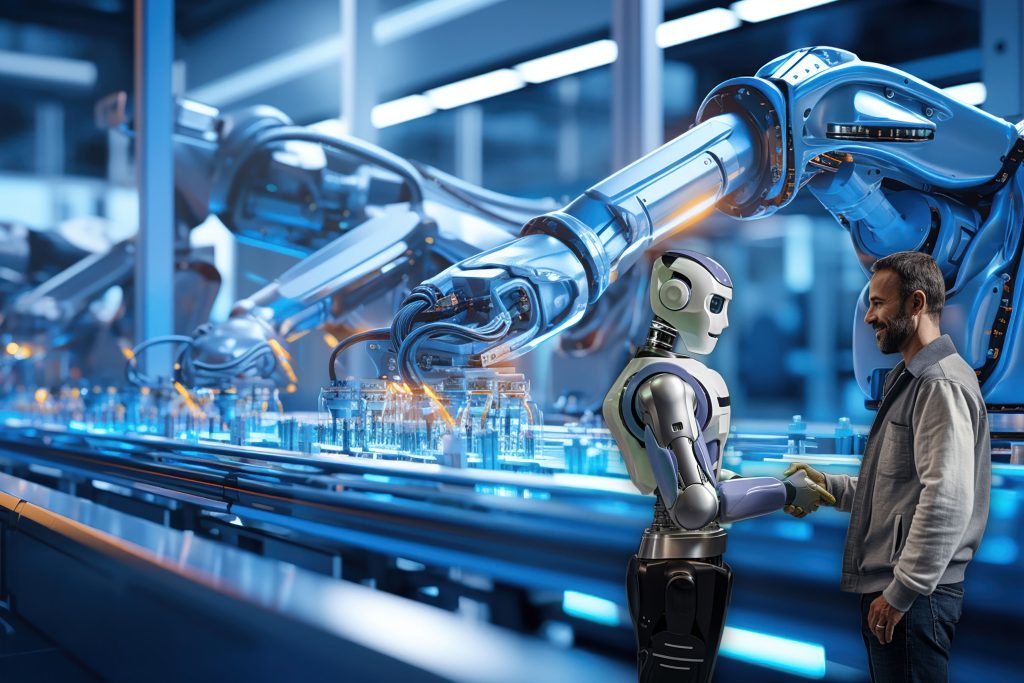
In modern manufacturing, integrating Artificial Intelligence is not about replacing human workers but enhancing their capabilities through collaboration. The synergy between AI and human intelligence presents a promising avenue for efficiency, innovation, and upskilling within the industry.
Many believe that Artificial Intelligence will take away human jobs in the manufacturing industry. But let’s look at it differently. AI isn’t our enemy; it’s our ally, helping us do better and achieve more. Furthermore, AI plays a pivotal role in upskilling the manufacturing workforce. By offering personalized training modules, adaptive learning experiences, and skill development programs, AI empowers employees to acquire new proficiencies and adapt to evolving industry demands swiftly. This proactive approach to workforce development enhances individual employability and future-proofs the industry against technological disruptions. This blog delves into the transformative potential of AI in manufacturing, focusing on its collaborative nature and role in upskilling the workforce.
Is it possible to build a perfect human-AI collaboration in the manufacturing industry?
Perfecting human-AI collaboration in the manufacturing industry is a dynamic goal that continues evolving with technological advancements and industry practices. While achieving perfection may be an ongoing journey, significant strides are being made towards maximizing the synergy between humans and AI in manufacturing.
Effective collaboration between humans and AI in manufacturing requires recognizing their complementary strengths and providing thorough training for workers. User-friendly interfaces and a focus on safety, reliability, and ethical considerations are essential. Continuous improvement through feedback and adaptation ensures optimal results, enabling manufacturers to revolutionize the industry.
Anyway, let’s check some of the advances of AI in the manufacturing industry.
Quality Control Enhancement
AI-powered visual inspection systems can analyze images of products in real time to identify defects or inconsistencies. While AI algorithms can efficiently detect patterns and anomalies, human workers can provide context and make judgment calls on nuanced issues. This collaborative approach ensures that quality standards are upheld while reducing the risk of false positives or negatives.
Inventory Management Optimization
Safety is paramount in the manufacturing industry, where workers are exposed to various hazards daily. AI algorithms can analyze historical data, market trends, and customer demand patterns to optimize inventory levels and procurement strategies. Human workers can then interpret these insights to make strategic decisions, such as adjusting production schedules or negotiating supplier contracts. By working together, AI and human workers can ensure that inventory levels are aligned with demand, minimizing excess stock and stockouts.
Robotics and Automation
AI-driven robotics are revolutionizing operations by automating repetitive and labor-intensive tasks like assembly and material handling. These robots, empowered by AI, exhibit adaptability to evolving environments, learning from their experiences to execute tasks with unparalleled precision and efficiency. AI-enabled robotics frees up human workers to focus on complex and strategic tasks by handling mundane activities. This shift not only enhances productivity but also stimulates innovation and creativity within the workforce.
AI in Workplace Safety
AI-enabled sensors and wearable devices play a pivotal role in monitoring environmental conditions and worker behavior to identify potential safety hazards in real time. These devices detect anomalies like high temperatures, chemical exposure, or unsafe machinery, allowing quick intervention to prevent accidents.
How Empowering Workers?
The collaborative approach between AI and human workers empowers employees to actively participate in maintaining workplace safety. By providing real-time alerts and actionable insights, AI enables workers to identify potential hazards before they escalate into accidents or injuries. This proactive approach fosters a culture of safety awareness and encourages workers to take ownership of the safety and the safety of their peers.
How do AI Algorithms work?
While AI algorithms excel at detecting anomalies, human intervention remains essential for interpreting alerts and taking appropriate actions to mitigate risks. Human workers can leverage their expertise and judgment to assess the situation, implement safety protocols, and ensure a safe working environment for themselves and their colleagues.
With their ability to analyze vast datasets and extract meaningful insights, AI algorithms play a pivotal role in predictive maintenance, process optimization, quality control, supply chain management, automation, and energy management. By predicting equipment failures before they occur, optimizing production processes, detecting defects with precision, forecasting demand accurately, automating repetitive tasks, and optimizing energy usage, AI algorithms revolutionize manufacturing operations.
How Does Data Labeling Help?
In manufacturing, the role of data labeling in AI is paramount for driving efficiency and innovation. Data labeling involves categorizing and annotating data to train AI algorithms effectively. In the manufacturing sector, labeled data enables AI systems to recognize patterns, optimize processes, and make informed decisions autonomously. From identifying defects in the production line to predicting equipment maintenance needs, accurately labeled data empowers AI to enhance quality control, streamline operations, and ultimately improve productivity. Moreover, ongoing data labeling ensures that AI systems continuously learn and adapt to evolving manufacturing environments, reinforcing their role as invaluable tools in driving the industry forward.
The Brief
In conclusion, the collaborative approach of AI and human workers is transforming workplace safety in manufacturing. The combined efforts of AI and human workers are reshaping workplace safety in manufacturing. Using AI-powered sensors and wearables, manufacturers can spot safety hazards instantly and help workers take proactive steps to reduce risks. This collaboration promotes a culture of safety awareness, ensuring employees can work confidently and securely. As technology progresses, the partnership between AI and human expertise will continue to improve safety standards in manufacturing.
While achieving perfect collaboration between humans and AI in manufacturing may be an ongoing endeavor, continuous advancements in technology and collaborative practices are bringing us closer to realizing this goal. By combining human and AI strengths and promoting collaboration, the manufacturing industry can achieve higher efficiency, innovation, and success.